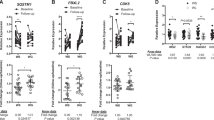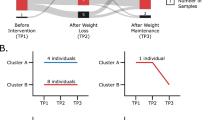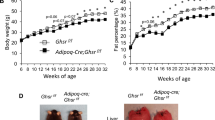Abstract
Background/Objectives:
Moderate weight loss (WL) can ameliorate adverse health effects associated with obesity, reflected by an improved adipose tissue (AT) gene expression profile. However, the effect of rate of WL on the AT transcriptome is unknown. We investigated the global AT gene expression profile before and after two different rates of WL that resulted in similar total WL, and after a subsequent weight stabilization period.
Subjects/Methods:
In this randomized controlled trial, 25 male and 28 female individuals (body mass index (BMI): 28–35 kg m−2) followed either a low-calorie diet (LCD; 1250 kcal day−1) for 12 weeks or a very-low-calorie diet (VLCD; 500 kcal day−1) for 5 weeks (WL period) and a subsequent weight stable (WS) period of 4 weeks. The WL period and WS period together is termed dietary intervention (DI) period. Abdominal subcutaneous AT biopsies were collected for microarray analysis and gene expression changes were calculated for all three periods in the LCD group, VLCD group and between diets (ΔVLCD−ΔLCD).
Results:
WL was similar between groups during the WL period (LCD: −8.1±0.5 kg, VLCD: −8.9±0.4 kg, difference P=0.25). Overall, more genes were significantly regulated and changes in gene expression appeared more pronounced in the VLCD group compared with the LCD group. Gene sets related to mitochondrial function, adipogenesis and immunity/inflammation were more strongly upregulated on a VLCD compared with a LCD during the DI period (positive ΔVLCD−ΔLCD). Neuronal and olfactory-related gene sets were decreased during the WL period and DI period in the VLCD group.
Conclusions:
The rate of WL (LCD vs VLCD), with similar total WL, strongly regulates AT gene expression. Increased mitochondrial function, angiogenesis and adipogenesis on a VLCD compared with a LCD reflect potential beneficial diet-induced changes in AT, whereas differential neuronal and olfactory regulation suggest functions of these genes beyond the current paradigm.
This is a preview of subscription content, access via your institution
Access options
Subscribe to this journal
Receive 12 print issues and online access
$259.00 per year
only $21.58 per issue
Buy this article
- Purchase on Springer Link
- Instant access to full article PDF
Prices may be subject to local taxes which are calculated during checkout




Similar content being viewed by others
References
Rosen ED, Spiegelman BM . What we talk about when we talk about fat. Cell 2014; 156: 20–44.
Hajer GR, van Haeften TW, Visseren FL . Adipose tissue dysfunction in obesity, diabetes, and vascular diseases. Eur Heart J 2008; 29: 2959–2971.
Kloting N, Bluher M . Adipocyte dysfunction, inflammation and metabolic syndrome. Rev Endocr Metab Disord 2014; 15: 277–287.
Tuomilehto J, Lindstrom J, Eriksson JG, Valle TT, Hamalainen H, Ilanne-Parikka P et al. Prevention of type 2 diabetes mellitus by changes in lifestyle among subjects with impaired glucose tolerance. N Engl J Med 2001; 344: 1343–1350.
Brown T, Avenell A, Edmunds LD, Moore H, Whittaker V, Avery L et al. Systematic review of long-term lifestyle interventions to prevent weight gain and morbidity in adults. Obes Rev 2009; 10: 627–638.
Capel F, Klimcakova E, Viguerie N, Roussel B, Vitkova M, Kovacikova M et al. Macrophages and adipocytes in human obesity: adipose tissue gene expression and insulin sensitivity during calorie restriction and weight stabilization. Diabetes 2009; 58: 1558–1567.
Johansson LE, Danielsson AP, Parikh H, Klintenberg M, Norstrom F, Groop L et al. Differential gene expression in adipose tissue from obese human subjects during weight loss and weight maintenance. Am J Clin Nutr 2012; 96: 196–207.
Duivenvoorde LP, van Schothorst EM, Bunschoten A, Keijer J . Dietary restriction of mice on a high-fat diet induces substrate efficiency and improves metabolic health. J Mol Endocrinol 2011; 47: 81–97.
Nisoli E, Tonello C, Cardile A, Cozzi V, Bracale R, Tedesco L et al. Calorie restriction promotes mitochondrial biogenesis by inducing the expression of eNOS. Science 2005; 310: 314–317.
Jahansouz C, Serrot FJ, Frohnert BI, Foncea RE, Dorman RB, Slusarek B et al. Roux-en-Y gastric bypass acutely decreases protein carbonylation and increases expression of mitochondrial biogenesis genes in subcutaneous adipose tissue. Obes Surg 2015; 25: 2376–2385.
You T, Nicklas BJ . Chronic inflammation: role of adipose tissue and modulation by weight loss. Curr Diabetes Rev 2006; 2: 29–37.
Capel F, Viguerie N, Vega N, Dejean S, Arner P, Klimcakova E et al. Contribution of energy restriction and macronutrient composition to changes in adipose tissue gene expression during dietary weight-loss programs in obese women. J Clin Endocrinol Metab 2008; 93: 4315–4322.
Vink RG, Roumans NJ, Arkenbosch LA, Mariman EC, van Baak MA . The effect of rate of weight loss on long-term weight regain in adults with overweight and obesity. Obesity 2016; 24: 321–327.
Smyth GK . Limma: linear models for microarray data. In: Gentleman R et al. (eds). Bioinformatics and Computational Biology Solutions Using R and Bioconductor. Springer: New York, NY, USA, 2005, pp 397–420.
Benjamini Y, Hochberg Y . Controlling the false discovery rate—a practical and powerful approach to multiple testing. J R Stat Soc B Met 1995; 57: 289–300.
Subramanian A, Tamayo P, Mootha VK, Mukherjee S, Ebert BL, Gillette MA et al. Gene set enrichment analysis: a knowledge-based approach for interpreting genome-wide expression profiles. Proc Natl Acad Sci USA 2005; 102: 15545–15550.
Smilde AK, Jansen JJ, Hoefsloot HC, Lamers RJ, van der Greef J, Timmerman ME . ANOVA-simultaneous component analysis (ASCA): a new tool for analyzing designed metabolomics data. Bioinformatics 2005; 21: 3043–3048.
Vis DJ, Westerhuis JA, Smilde AK, van der Greef J . Statistical validation of megavariate effects in ASCA. BMC Bioinformatics 2007; 8: 322.
Kosteli A, Sugaru E, Haemmerle G, Martin JF, Lei J, Zechner R et al. Weight loss and lipolysis promote a dynamic immune response in murine adipose tissue. J Clin Invest 2010; 120: 3466–3479.
Hotamisligil GS . Inflammation and metabolic disorders. Nature 2006; 444: 860–867.
Cancello R, Henegar C, Viguerie N, Taleb S, Poitou C, Rouault C et al. Reduction of macrophage infiltration and chemoattractant gene expression changes in white adipose tissue of morbidly obese subjects after surgery-induced weight loss. Diabetes 2005; 54: 2277–2286.
Heinonen S, Buzkova J, Muniandy M, Kaksonen R, Ollikainen M, Ismail K et al. Impaired mitochondrial biogenesis in adipose tissue in acquired obesity. Diabetes 2015; 64: 3135–3145.
Rossmeislova L, Malisova L, Kracmerova J, Tencerova M, Kovacova Z, Koc M et al. Weight loss improves the adipogenic capacity of human preadipocytes and modulates their secretory profile. Diabetes 2013; 62: 1990–1995.
Cristancho AG, Lazar MA . Forming functional fat: a growing understanding of adipocyte differentiation. Nature Rev Mol Cell Biol 2011; 12: 722–734.
Bartness TJ, Liu Y, Shrestha YB, Ryu V . Neural innervation of white adipose tissue and the control of lipolysis. Front Neuroendocrinol 2014; 35: 473–493.
Patel JN, Coppack SW, Goldstein DS, Miles JM, Eisenhofer G . Norepinephrine spillover from human adipose tissue before and after a 72- hour fast. J Clin Endocrinol Metab 2002; 87: 3373–3377.
Cleland TA . Construction of odor representations by olfactory bulb microcircuits. Prog Brain Res 2014; 208: 177–203.
Palouzier-Paulignan B, Lacroix MC, Aime P, Baly C, Caillol M, Congar P et al. Olfaction under metabolic influences. Chem Senses 2012; 37: 769–797.
Stafford LD, Whittle A . Obese individuals have higher preference and sensitivity to odor of chocolate. Chem Senses 2015; 40: 279–284.
van Helden YG, Godschalk RW, Heil SG, Bunschoten A, Hessel S, Amengual J et al. Downregulation of Fzd6 and Cthrc1 and upregulation of olfactory receptors and protocadherins by dietary beta-carotene in lungs of Bcmo1-/- mice. Carcinogenesis 2010; 31: 1329–1337.
Primeaux SD, Braymer HD, Bray GA . High fat diet differentially regulates the expression of olfactory receptors in the duodenum of obesity-prone and obesity-resistant rats. Dig Dis Sci 2013; 58: 72–76.
Mariman EC, Szklarczyk R, Bouwman FG, Aller EE, van Baak MA, Wang P . Olfactory receptor genes cooperate with protocadherin genes in human extreme obesity. Genes Nutr 2015; 10: 465.
Henegar C, Tordjman J, Achard V, Lacasa D, Cremer I, Guerre-Millo M et al. Adipose tissue transcriptomic signature highlights the pathological relevance of extracellular matrix in human obesity. Genome Biol 2008; 9: R14.
Kolehmainen M, Salopuro T, Schwab US, Kekalainen J, Kallio P, Laaksonen DE et al. Weight reduction modulates expression of genes involved in extracellular matrix and cell death: the GENOBIN study. Int J Obes 2008; 32: 292–303.
Divoux A, Tordjman J, Lacasa D, Veyrie N, Hugol D, Aissat A et al. Fibrosis in human adipose tissue: composition, distribution, and link with lipid metabolism and fat mass loss. Diabetes 2010; 59: 2817–2825.
Mariman EC, Wang P . Adipocyte extracellular matrix composition, dynamics and role in obesity. Cell Mol Life Sci 2010; 67: 1277–1292.
Divoux A, Clement K . Architecture and the extracellular matrix: the still unappreciated components of the adipose tissue. Obes Rev 2011; 12: e494–e503.
Gaj S, Eijssen L, Mensink RP, Evelo CT . Validating nutrient-related gene expression changes from microarrays using RT(2) PCR-arrays. Genes Nutr 2008; 3: 153–157.
Acknowledgements
We thank the study participants for their contribution to the trial. We also like to thank Martina Kutmon and Michiel Adriaens from Maastricht Centre for Systems Biology (MaCSBio) for their suggestions and assistance. This project/research has been made possible with support of the Dutch Province of Limburg. This study was supported by the Netherlands Organisation for Scientific Research TOP, Grant Number: 200500001.
Author information
Authors and Affiliations
Corresponding author
Ethics declarations
Competing interests
The authors declare no conflict of interest.
Additional information
Supplementary Information accompanies this paper on International Journal of Obesity website
Supplementary information
Rights and permissions
About this article
Cite this article
Vink, R., Roumans, N., Fazelzadeh, P. et al. Adipose tissue gene expression is differentially regulated with different rates of weight loss in overweight and obese humans. Int J Obes 41, 309–316 (2017). https://doi.org/10.1038/ijo.2016.201
Received:
Revised:
Accepted:
Published:
Issue Date:
DOI: https://doi.org/10.1038/ijo.2016.201
This article is cited by
-
Adipocyte p53 coordinates the response to intermittent fasting by regulating adipose tissue immune cell landscape
Nature Communications (2024)
-
Obesity-induced and weight-loss-induced physiological factors affecting weight regain
Nature Reviews Endocrinology (2023)
-
Molecular remodeling of adipose tissue is associated with metabolic recovery after weight loss surgery
Journal of Translational Medicine (2022)
-
Stratifying cellular metabolism during weight loss: an interplay of metabolism, metabolic flexibility and inflammation
Scientific Reports (2020)
-
Prioritizing putative influential genes in cardiovascular disease susceptibility by applying tissue-specific Mendelian randomization
Genome Medicine (2019)



